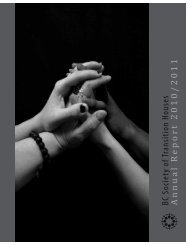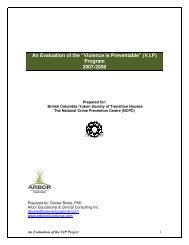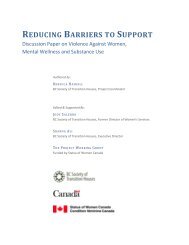a guide to supporting children exposed to domestic violence
a guide to supporting children exposed to domestic violence
a guide to supporting children exposed to domestic violence
Create successful ePaper yourself
Turn your PDF publications into a flip-book with our unique Google optimized e-Paper software.
• If they continue <strong>to</strong> hit/swear, send them <strong>to</strong> another room <strong>to</strong> cool off. If you’re<br />
afraid they’re so angry that they might hurt themselves or destroy property,<br />
insist that they sit quietly where you can see them. You may need <strong>to</strong> hold a<br />
younger child.<br />
• Go off <strong>to</strong> another room yourself. S<strong>to</strong>p any interaction until they are calm. Don’t<br />
choose this option if <strong>children</strong> are getting hurt or property destroyed.<br />
• When they are calm, problem-solve with them about other ways <strong>to</strong> handle the<br />
issue.<br />
TEACH YOUR CHILDREN HOW TO MANAGE THEIR ANGER<br />
Teach your <strong>children</strong> how <strong>to</strong> communicate anger without being disrespectful. You<br />
can show them how <strong>to</strong> use “I statements.” For instance: “When you take my doll<br />
without permission, I feel angry/hurt/sad.”<br />
They can also learn other ways <strong>to</strong> express angry feelings. Examples: scribbling on<br />
or tearing up paper or old phone books, doing push-ups, skipping, running round<br />
the block, talking, writing or drawing about their feelings.<br />
With young <strong>children</strong> who are angry, diversion may be best. Try <strong>to</strong> shift a <strong>to</strong>ddler<br />
or preschooler’s attention away from what they are mad at. Give them something<br />
else <strong>to</strong> do.<br />
Meng‘s s<strong>to</strong>ry<br />
Meng had been a quiet and obedient child. When her family immigrated <strong>to</strong> Canada<br />
she was intimidated by Canadian <strong>children</strong>, who seemed noisy and often did not<br />
respect their parents.<br />
Meng married young, <strong>to</strong> an older man. After the first child was born her husband<br />
became angry and irritable. He wanted Meng’s attention and resented the time she<br />
spent with the <strong>children</strong>. He <strong>to</strong>ld her she was a useless wife and mother, and criticized<br />
everything she did. Sometimes he hit her.<br />
When her second child became defiant, had temper tantrums and called her names,<br />
Meng was horrified and scared. She didn’t know what <strong>to</strong> do.<br />
With the help of a Children Who Witness Abuse counsellor, she realized that her<br />
husband’s behaviour was influencing the <strong>children</strong>. The <strong>children</strong> attended a Children<br />
Who Witness Abuse group and Meng talked <strong>to</strong> a counsellor. The <strong>children</strong> learned<br />
about safe ways of expressing anger, and Meng was able <strong>to</strong> use these ideas at<br />
home.<br />
HELPING MY CHILD A GUIDE TO SUPPORTING CHILDREN EXPOSED TO DOMESTIC VIOLENCE 43






